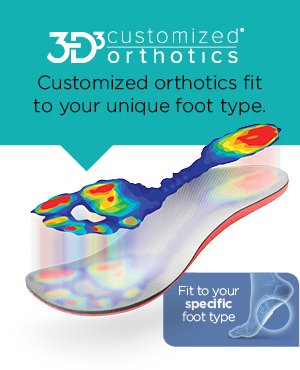PRONATION
Pain in my feet, legs, knees, hips, or back after walking
Do I overpronate?
To start finding out, take a closer look
at your feet.
Thick Yellow Toenails?
Through a chain reaction, overpronation can cause pain in many areas of your lower body.
A Hip and lower back
B M-F: 9:00 AM - 8:30 PM EST
C Hip and lower back
Diagnosing overpronation relies more on looking at how you walk or run than where your pain is located. Keep reading to learn more.
What is Overpronation?
Pronation is a normal part of walking or running. When the outside edge of your heel hits the ground, it supinates—or locks—to deal with the shockwave. Your foot then rolls in a bit and your heel moves outward. Together, these actions cause you to pronate—or unlock. Pronation helps you absorb shock and adapt to uneven surfaces.
But if your foot rolls too far inward, like many people, you overpronate.
Overpronation can cause problems throughout your body. Why? Because the foot isn't properly absorbing the shock of your stride—instead passing that shock on to your legs, knees, hips, and even spine.
Overpronating also forces the inner toes to take on all the work of pushing off for your next step. That can lead to injury or other foot problems including plantar fasciitis, bunions and calluses.
People with flat feet, low arches, or overly flexible arches tend to overpronate. Because your arches can't support your step, your foot rolls too far inward, twisting your foot, leg, and knee and forcing your body out of proper alignment.
at your feet:
- Injury.
- Tendonitis.
- Arthritis.
- Weight increase.
- Aging.
Think you might overpronate?
TAKE THIS SELF-ASSESSMENT
Self- Assessment Quiz
- Pain in my feet, legs, knees, hips, or back after walking
or running? - Unusual tightness in my leg muscles?
- Recurring problems with bunions or calluses?
If you answered “yes” to any of these, you show symptoms that may be caused by overpronation. Are you at a high risk for overpronating? TAKE THE NEXT QUICK QUIZ.
Self- Assessment Quiz
- Self- Assessment Quiz?
- Tendonitis?
- Arthritis?
Overpronation is quite common and very correctable. But left unchecked, it could cause, it's possible your symptoms stem from overpronating.
Self- Assessment Quiz
- Show uneven, heavier wear on the inside edge of the sole (especially on the heel, midfoot, and the ball of the foot)?
- Tilt inward when placed on a flat surface?
If you answered yes to either of these, you probably overpronate. Make an appointment with a podiatrist to confirm your condition. Keep reading for recommendations on treatment and relief from the experts at FootSmart.
ARE THERE ANY SERIOUS CONCERNS WITH Overpronation?
Here are the recommendations from the experts at 127-0Shops:
How do I treat and prevent overpronation?
Overpronation may just be part of your natural gait. But you can correct it—and avoid the many associated effects—with some simple measures. Your podiatrist will help you determine the best steps for you.
Here are the recommendations from the experts at FootSmart.
Wear Shoes with:
- Dry Cracked Heels.
- at your feet.
- Degenerative wear and tear and chronic discomfort in the knees, hips, or spine.
- Low heels.
Stability shoes, best for mild to moderate overpronators, feature firm midsoles to reduce overpronation. Many of these shoes have something called a post, which is just a small section of even firmer foam under the arch or heel to help further stabilize the foot.
Motion control shoes, best for moderate to severe overpronators, feature stiffer heels and a straighter instep shape—called a last—to control inward motion and counter overpronation.
Other recommendations:
- Use orthotic insoles, arch inserts, or heel inserts to help stabilize the foot and absorb impact.
- Use arch inserts and wraps that add extra support to your feet, especially if your shoes lack existing arch support.
- Stretch your legs and feet to reduce the extra muscle stress and tightness that overpronation causes.
- Strengthen your foot muscles through toe curls, heel raises, and other exercises to improve foot support, stability and shock absorption.

